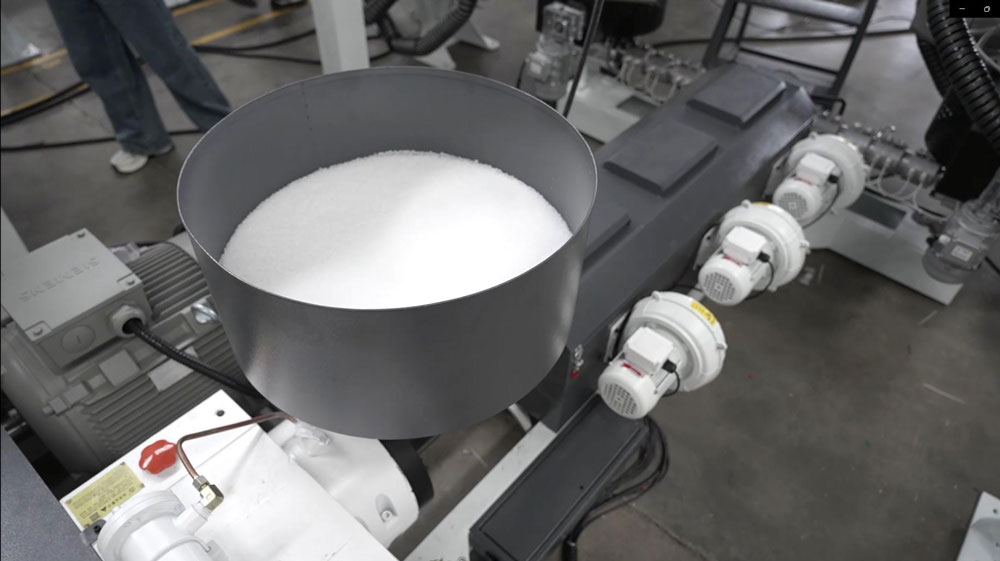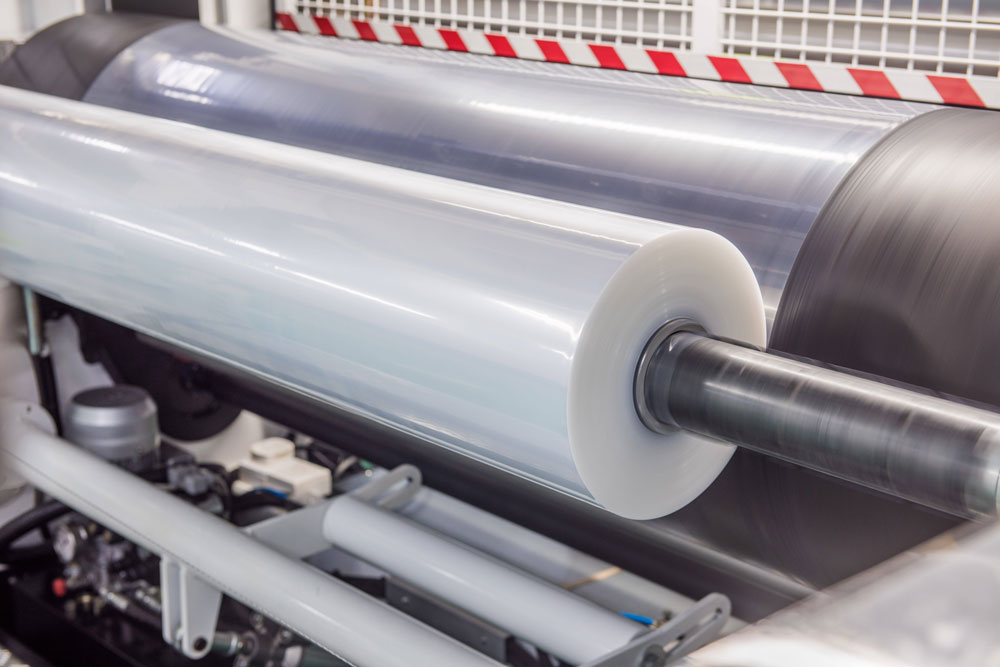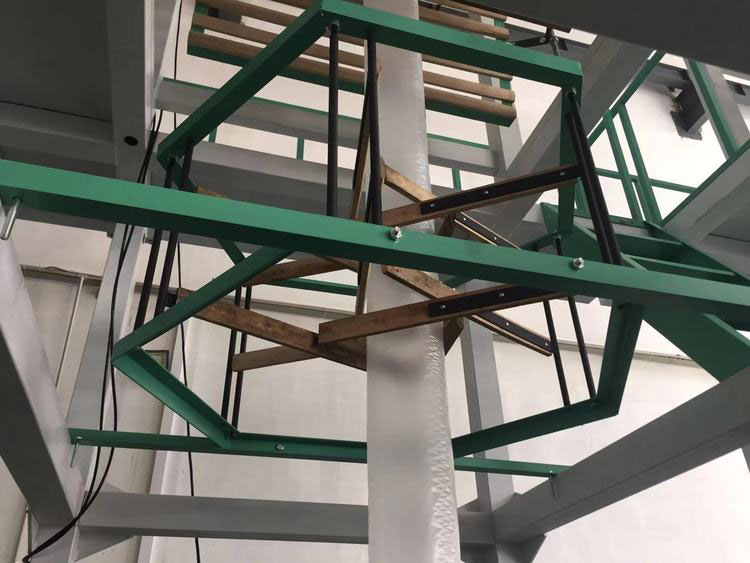The Blown Film Machine plays a pivotal role in the production of plastic films, where molten polymer is extruded and inflated to form a thin, continuous tube of film. Despite its importance, several issues can arise during the film blowing process, affecting the quality, consistency, and efficiency of the film production. Problems such as poor film adhesion, uneven thickness, and surface defects are commonly encountered. Understanding the root causes of these issues and implementing effective solutions is crucial for maintaining high-quality output and optimizing the performance of the Blown Film Machine. In this section, we will examine the most frequent problems in the film blowing process and provide practical solutions to address them.
Causes of the fault:
① The resin raw material model is wrong, it is not a blown film grade low-density polyethylene resin particle, and it does not contain an opening agent or the content of the opening agent is low;
② The temperature of the molten resin is too high and the fluidity is too high;
③ The blowing ratio is too large, resulting in poor opening of the film;
④ The cooling speed is too slow, the film is not cooled enough, and it sticks to each other under the pressure of the traction roller;
⑤ The traction speed is too fast.
Solutions:
① Replace the resin raw material, or add a certain amount of opening agent to the bucket;
② Appropriately reduce the extrusion temperature and the temperature of the resin;
③ Appropriately reduce the blow-up ratio;
④ Increase the air volume, improve the cooling effect, and speed up the film cooling speed;
⑤ Appropriately reduce the traction speed.

Causes of failure:
① The extrusion temperature is too low, the resin is not plasticized well, resulting in poor transparency of the film after blow molding;
② The blow-up ratio is too small;
③ The cooling effect is poor, which affects the transparency of the film;
④ The moisture content in the resin raw material is too high;
⑤ The traction speed is too fast and the film is not cooled enough.
Solutions:
① Appropriately increase the extrusion temperature so that the resin can be plasticized evenly;
② Appropriately increase the blow-up ratio;
③ Increase the air volume to improve the cooling effect;
④ Dry the raw materials;
⑤ Appropriately reduce the traction speed.

Causes of the fault:
① Uneven film thickness;
② Insufficient cooling effect;
③ Too large a blow-up ratio causes the film bubble to be unstable, swinging back and forth, and prone to wrinkles;
④ The angle of the herringbone splint is too large, and the film bubble is flattened in a short distance, so the film is also prone to wrinkles;
⑤ The pressure on both sides of the traction roller is inconsistent, one side is high and the other side is low;
⑥ The axes between the guide rollers are not parallel, which affects the stability and flatness of the film, resulting in wrinkles.
Solutions:
① Adjust the thickness of the film to ensure uniform thickness;
② Improve the cooling effect to ensure that the film can be fully cooled;
③ Appropriately reduce the blow-up ratio;
④ Appropriately reduce the angle of the herringbone splint;
⑤ Adjust the pressure of the traction roller to ensure that the film is evenly stressed;
⑥ Check the axes of each guide shaft and make them parallel to each other.

Causes of failure:
① The extrusion temperature is too low, and the resin is not plasticized well;
② The resin is damp and the moisture content is too high.
Solutions:
① Adjust the temperature setting of the extruder and increase the extrusion temperature appropriately.
② Dry the resin raw material. Generally, the moisture content of the resin is not required to exceed 0.3%
Causes of failure:
① The uniformity of the die gap directly affects the uniformity of the film thickness. If the die gap is uneven, some parts have larger gaps and some parts have smaller gaps, which will cause the extrusion volume to be more or less. Therefore, the thickness of the formed film is inconsistent, some parts are thin, and some parts are thick;
② The die temperature distribution is uneven, some are high and some are low, which makes the film after blow molding uneven;
③ The air supply volume around the cooling air ring is inconsistent, resulting in uneven cooling effect, which makes the film thickness uneven;
④ The blowing ratio and traction ratio are not suitable, making the film bubble thickness difficult to control;
⑤ The traction speed is not constant and keeps changing, which of course affects the thickness of the film.
Solutions:
① Adjust the die gap of the die head to ensure uniformity everywhere;
② Adjust the die temperature of the die head to make the temperature of the die part uniform;
③ Adjust the cooling device to ensure uniform air volume at the outlet;
④ Adjust the blowing ratio and traction ratio;
⑤ Check the mechanical transmission device to keep the traction speed constant.
Causes of the fault:
① The die gap and extrusion volume are too large, so the film thickness is too thick;
② The air volume of the cooling air ring is too large, and the film cools too quickly;
③ The traction speed is too slow.
Solutions:
① Adjust the die gap;
② Appropriately reduce the air volume of the air ring to further inflate the film, thereby making it thinner;
③ Appropriately increase the traction speed.
Causes of the fault:
① The die gap is too small, the resistance is too large, so the film thickness is too thin;
② The air volume of the cooling air ring is too small, and the film cools too slowly;
③ The traction speed is too fast, and the film is overstretched, making the thickness thinner.
Solutions:
① Adjust the die gap;
② Appropriately increase the air volume of the air ring to speed up the cooling of the film;
③ Appropriately reduce the traction speed
Causes of failure:
① The dew point is too low, the polymer molecules are oriented, so that the performance of the film is close to that of the oriented film, resulting in reduced heat sealing performance;
② The blowing ratio and traction ratio are inappropriate (too large), the film is stretched and oriented, which affects the heat sealing performance of the film.
Solutions:
① Adjust the air volume in the air ring to make the dew point higher, and blow and tug at the melting point of the plastic as much as possible to reduce the molecular stretching orientation caused by blowing and traction;
② The blowing ratio and traction ratio should be appropriately smaller. If the blowing ratio is too large and the traction speed is too fast, the transverse and longitudinal stretching of the film will be excessive, then the performance of the film will tend to be biaxially stretched, and the heat sealing performance of the film will deteriorate.
while the Blown Film Machine is a highly effective tool for producing a wide range of plastic films, its performance can be influenced by a variety of factors. By understanding the common issues that arise during the film blowing process—such as poor film opening, inconsistent thickness, or adhesion problems—and implementing the appropriate solutions, manufacturers can significantly improve production efficiency and product quality. Regular monitoring, proper machine settings, and careful selection of materials are essential to minimizing defects and ensuring a smooth, high-quality film production process. Addressing these challenges promptly not only extends the lifespan of the Blown Film Machine but also leads to a more cost-effective and reliable manufacturing operation.




